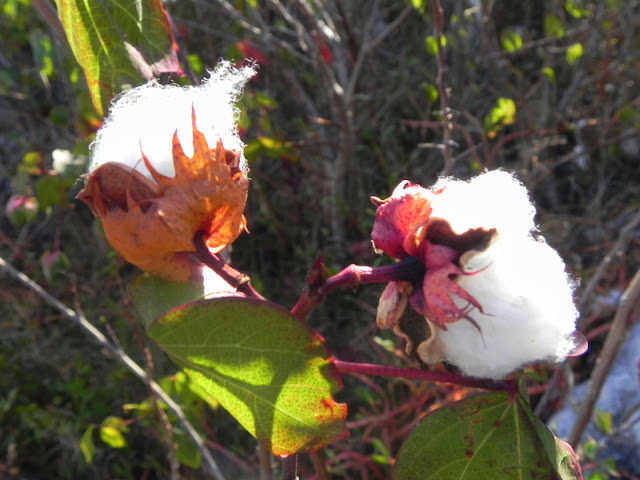I am ashamed to admit just how long it has been since I have featured a Field Guide Friday post. That is all going to change now that I have a file folder full of local species identified (thank you Naqqi)! First up, locally known as Wild Cotton or Sea Island Cotton, Gossypium hirsutum. The photos above were taken in January of 2012 on the way to Southwest Bluff, an area where there were a great concentration, but if you are driving around Providenciales this time of year you are likely to see these fluffy white poofs by the side of the road in many areas. Contrary to popular belief, it was not the British Loyalists who introduced this species to the Turks and Caicos. It came long before, but by whom? For a couple of hints, reference the wikipedia link above; "native to Central America" and "cultivated for over 5,000 years." A people who were weaving the cotton, not into clothing, but very cleverly into sleeping hammocks and mosquito netting. Have you figured it out? Whether your certain or stumped, you must read this fascinating article to discover this and so much more: Back In Time Sea Island Cotton.
Image above and images below via the brilliant botanist, B Naqqi Manco, who captured this thriving wild cotton in Lorimers, Middle Caicos in 2012. Remarkable the white and pink colored blossoms stemming from the same plant! This lovely looker seems to be spared entirely from the Cotton Seed Bug, Oxycarenus hyalinipennis. Referencing this CAPS Survey Report; "In the
Western Hemisphere, it was first documented in the North Caicos Islands in 1991 (Slater
and Baranowski 1994); and by 2005, it had been observed throughout the Turks and
Caicos, the Bahamas, the Cayman Islands and Hispaniola (Baranowski and Slater 2005)."
Western Hemisphere, it was first documented in the North Caicos Islands in 1991 (Slater
and Baranowski 1994); and by 2005, it had been observed throughout the Turks and
Caicos, the Bahamas, the Cayman Islands and Hispaniola (Baranowski and Slater 2005)."
The cotton industry in the Turks and Caicos was sadly quite short lived due to the invention of the Cotton Gin, the quality of the soil, and another unfortunate pest, the Boll Weevil. I have often thought about creative uses for the cotton we still have growing on this island, someday I will hopefully have the opportunity to style with the fluffy stuff like this rustic-wedding-decor-creative-with-cotton!






The reason for the two-coloured flowers on the same bush is pretty amazing. Insects see ultraviolet pigments well, even though they're invisible to us. UV pigments are blocked by most other pigments, especially reds and blues, but not yellows and whites. The flowers open yellow and (though we can't see them) they have dotted lines and actual arrows in UV pigments pointing toward the middle of the flower -- a landing strip and directions for pollinating insects! Many insects are hard-wired so they can't actually choose not to land on the flowers they see. After the flower is pollinated, it doesn't want more insects coming that could risk knocking pollen off the stigma, so the size of the anthocyanin-bearing cells (red pigment) dramatically increases, flushing the flower red, concealing the UV markings -- in effect shutting down the runway and diverting the insect to another flower.
ReplyDelete